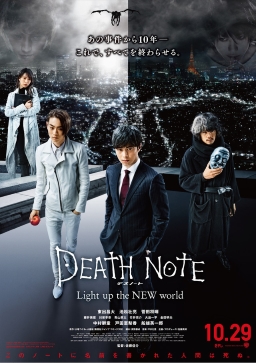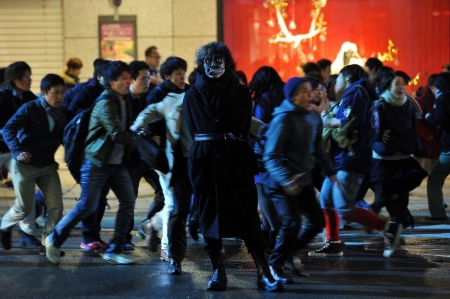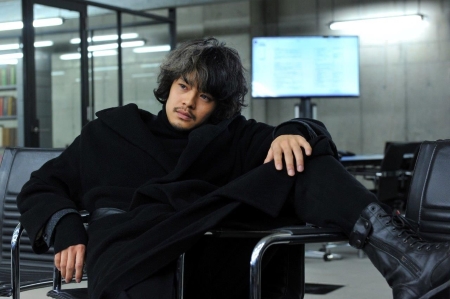Fantasia 2017, Day 13: Death Note: Light Up The New World
 On Tuesday, July 25, I watched two movies at the Fantasia Film Festival. One was Atomic Blonde, which I’ve already written about. Right before that, though, I was able to see Death Note: Light Up the New World (Death Note – Desu nôto: Light Up the New World), the latest installment in the live-action Japanese Death Note film series. The movies are of course based on the best-selling manga by writer Tsugumi Ohba and artist Takeshi Obata; three movies have preceded this one, 2006’s Death Note and Death Note: The Last Name along with spin-off Death Note: L Change the World in 2008. There have been anime adaptations, light novels, TV mini-series, and, infamously, a Netflix remake. I cannot claim to be familiar with the source material of the Death Note franchise, but I found myself curious about the film and decided to see how this movie worked as an introduction to the story.
On Tuesday, July 25, I watched two movies at the Fantasia Film Festival. One was Atomic Blonde, which I’ve already written about. Right before that, though, I was able to see Death Note: Light Up the New World (Death Note – Desu nôto: Light Up the New World), the latest installment in the live-action Japanese Death Note film series. The movies are of course based on the best-selling manga by writer Tsugumi Ohba and artist Takeshi Obata; three movies have preceded this one, 2006’s Death Note and Death Note: The Last Name along with spin-off Death Note: L Change the World in 2008. There have been anime adaptations, light novels, TV mini-series, and, infamously, a Netflix remake. I cannot claim to be familiar with the source material of the Death Note franchise, but I found myself curious about the film and decided to see how this movie worked as an introduction to the story.
Light Up the New World is the first Death Note film directed by Shinsuke Sato, who helmed the wonderful adaptations of the Library Wars novels. You can see a similar visual sensibility in the lighting and sets, a near-future feel that helps make the fantastic aspects of the story more credible — precisely because the story isn’t grounded in everyday realism, it’s easier to believe. The movie starts with a quick introduction: the lord of death sent a notebook into the world that commands a Reaper, an angel of death named Ryuk (voiced by Shidô Nakamura); Ryuk would kill anyone whose name was written in the book. Pleased with the results of this ploy, Death now sends six books into the world, and awaits results. Which come to a boil some time later, as the movie begins.
There’s a prologue in Russia, then a chase scene in Japan, following a woman running through a crowd scribing names and slaughtering people. This leads to a discussion of the current situation: years after the original Death Note, when a youth named Light Yagami (Tatsuya Fujiwara, reprising his role from the earlier movies) built a false identity as ‘Kira’ and drew a crowd of followers by killing powerful evildoers, someone claiming to be Kira is back at work. Is it really Yagami, returned from the dead, or is someone acting in his name? The Death Note Task Force is reconstituted, and the police set to work desperately trying to track down the new Kira.
 The story settles down quickly into something that’s not quite horror and not quite an action film, but an odd blending of elements of both. It’s a dark fantasy intrigue tale, a suspense story involving the slow uncovering of mysteries and the exploitation of the specific rules of the notebooks. As such, it’s mostly effective. The pacing’s strong, moving swiftly and logically from scene to scene, and the story’s consistently dramatically interesting — the pressure the characters are under is clear, as is the sense that death could come at any moment from an unseen hand half a world away writing a name.
The story settles down quickly into something that’s not quite horror and not quite an action film, but an odd blending of elements of both. It’s a dark fantasy intrigue tale, a suspense story involving the slow uncovering of mysteries and the exploitation of the specific rules of the notebooks. As such, it’s mostly effective. The pacing’s strong, moving swiftly and logically from scene to scene, and the story’s consistently dramatically interesting — the pressure the characters are under is clear, as is the sense that death could come at any moment from an unseen hand half a world away writing a name.
There is an unlikely twist early on, as a character from the first story is ‘revived’ in the form of another character grown from his DNA, but at least for me it wasn’t enough to break the story — it is in fact early enough that it helps to establish what kind of story this is. That helps because the resolution, while within the rules the story lays down, pushes what one is likely to accept. Symobolically, it’s apt. But dramatically it feels both unlikely and clichéd.
Still, the movie works. Its sheer momentum likely helps. It’s consistently watchable moment-to-moment, the building tensions and the solidity of the scene construction keeping the viewer always engaged. It’s also visually smooth, atmospheric without being at all gothic; hard not to get of a kind of low-impact cyberpunk-horror frisson. The computer graphics, specifically of the Reapers, are a touch too cartoonish for me personally, though the designs are solid. More of a concern is the supposed December setting, which looks and feels unlikely.
 As a newcomer to the series I found the movie entertaining, though not deeply engaging. I suspect people with a pre-existing interest in the characters are more likely to be rewarded (some characters from the first story do, in fact, recur). The acting is solid, helping to sell the story without presenting the characters as caricatures. That’s important, I think, both because the story involves fantastic elements, and because those elements are at the core of what makes the story work. If there are soap operatic elements here, they’re there for the sake of exploring genre.
As a newcomer to the series I found the movie entertaining, though not deeply engaging. I suspect people with a pre-existing interest in the characters are more likely to be rewarded (some characters from the first story do, in fact, recur). The acting is solid, helping to sell the story without presenting the characters as caricatures. That’s important, I think, both because the story involves fantastic elements, and because those elements are at the core of what makes the story work. If there are soap operatic elements here, they’re there for the sake of exploring genre.
As a contrast, I’d point to the Netflix version of Death Note, which I watched in preparation for this review. It’s not a good movie on a number of levels, and I couldn’t help but suspect that one of the ways it misfired was by deciding that the tale it was telling was, in essence, a love story. The basic ideas and themes inherent in the device of the notebook pull in another direction, away from love and toward death. Toward, in fact, the power of life and death.
Which is largely what we get here. The movie made an interesting companion to Atomic Blonde, both intrigue thrillers with strong genre elements. But Atomic Blonde struck me as largely hollow; I walked out of the theatre entertained enough, but not sure what the point was. Light Up the New World is very different. It’s about, in large part, the corruption of power. It’s about how good intentions go bad. It’s about a threat to the existing political order of the world, but about the ways in which any replacement power means compromise as well, starting very likely with the violence that sets the new power in place.
 The cult of Kira helps drive events in Light Up the New World. Part of the tension of the film comes from knowing that there’s a good argument for Kira (and/or his successor) as a hero, and knowing that a large of number of people see nothing complicated in his actions and his murders — he is, if you like, the Punisher on a larger scale. I think it’s a mistake to say that the film supports existing structures in the world so much as it challenges the idea that the subversion of that order is, in the long run, enough in and of itself. And I think it raises some pointed questions about what the attempt at vigilante justice does to those who engage in it.
The cult of Kira helps drive events in Light Up the New World. Part of the tension of the film comes from knowing that there’s a good argument for Kira (and/or his successor) as a hero, and knowing that a large of number of people see nothing complicated in his actions and his murders — he is, if you like, the Punisher on a larger scale. I think it’s a mistake to say that the film supports existing structures in the world so much as it challenges the idea that the subversion of that order is, in the long run, enough in and of itself. And I think it raises some pointed questions about what the attempt at vigilante justice does to those who engage in it.
That’s enough to make it a success, in my mind. I didn’t think it was a great film, but it was effective. As you watch it, you’re not concerned with the relatively underplayed responses from governments around the world — one shudders to think what a realistic reaction to Kira’s actions would be from politicians aware that at any moment an unknown idealist could kill them at a stroke. We don’t need to know that, though. We don’t need to see a more massive operation to apprehend Kira. What we get is enough to make the story clear. The focus works. The movie’s not a total success, maybe, but it does what it wants to do.
(See all my 2017 Fantasia reviews here.)
Matthew David Surridge is the author of “The Word of Azrael,” from Black Gate 14. You can buy his first collection of essays, looking at some fantasy novels of the twenty-first century, here. His second collection, looking at some fantasy from the twentieth century, is here. You can find him on Facebook, or follow his Twitter account, Fell_Gard.